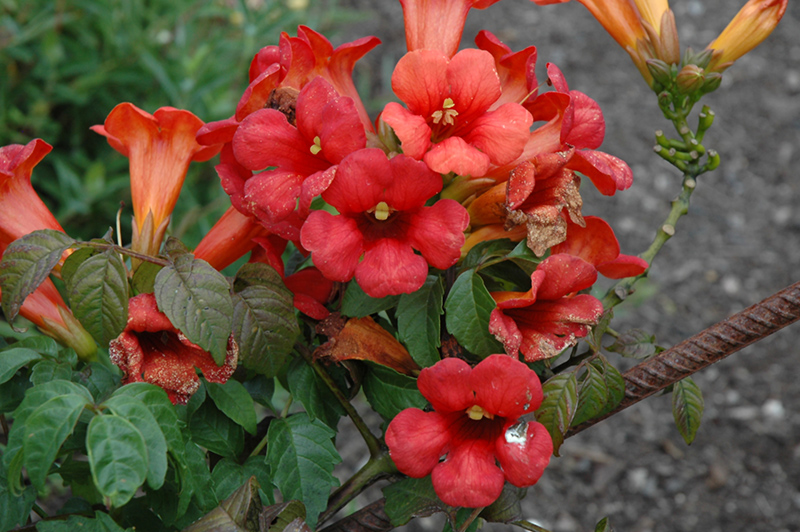Height: 6 feet Spread: 24 inches
Sunlight:
Hardiness Zone: 4b Other Names: Trumpetcreeper Group/Class: Summer Jazz Series Description: This smaller variety is compact and tame; clusters of luxurious red-orange blooms are visually stunning; excellent for containers and small trellises; grows very quickly and covers by self clinging Ornamental Features Summer Jazz™ Fire Trumpetvine features bold clusters of red trumpet-shaped flowers with orange overtones at the ends of the branches from late spring to early fall. It has dark green deciduous foliage. The serrated pointy pinnately compound leaves turn yellow in fall. Landscape Attributes Summer Jazz™ Fire Trumpetvine is a dense multi-stemmed deciduous woody vine with a twining and trailing habit of growth. Its average texture blends into the landscape, but can be balanced by one or two finer or coarser trees or shrubs for an effective composition. This woody vine will require occasional maintenance and upkeep, and can be pruned at anytime. It is a good choice for attracting birds and hummingbirds to your yard, but is not particularly attractive to deer who tend to leave it alone in favor of tastier treats. Gardeners should be aware of the following characteristic(s) that may warrant special consideration; Summer Jazz™ Fire Trumpetvine is recommended for the following landscape applications; Planting & Growing Summer Jazz™ Fire Trumpetvine will grow to be about 6 feet tall at maturity, with a spread of 24 inches. As a climbing vine, it tends to be leggy near the base and should be underplanted with low-growing facer plants. It should be planted near a fence, trellis or other landscape structure where it can be trained to grow upwards on it, or allowed to trail off a retaining wall or slope. It grows at a fast rate, and under ideal conditions can be expected to live for approximately 20 years. This woody vine does best in full sun to partial shade. It is very adaptable to both dry and moist locations, and should do just fine under average home landscape conditions. It is considered to be drought-tolerant, and thus makes an ideal choice for xeriscaping or the moisture-conserving landscape. It is not particular as to soil type or pH, and is able to handle environmental salt. It is highly tolerant of urban pollution and will even thrive in inner city environments. This is a selection of a native North American species.![]()
![]()
![]()
![]()
![]()
![]()
![]()
![]()
![]()
![]()
martha@rainfrostnursery.com
| 2452 Bethel Church Rd, Forest, VA 24551
Call us Today! (434) 525-3107
NetPS
Plant Finder
Characteristics
Applications
Features & Attributes
Phone:
(434) 525-3107 |
Email:
martha@rainfrostnursery.com |
Fax: 434-525-2062
Address: 2452 Bethel Church Rd, Forest, VA 24551
Business Hours:
Retail Nursery Hours are 9 to 5 Monday through Sat. | Closed Sundays




Content, including images, displayed on this website is protected by copyright laws. Downloading, republication, retransmission or reproduction of content on this website is strictly prohibited. Terms of Use
| Privacy Policy


